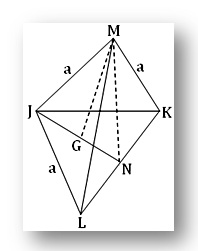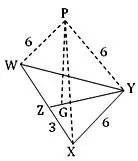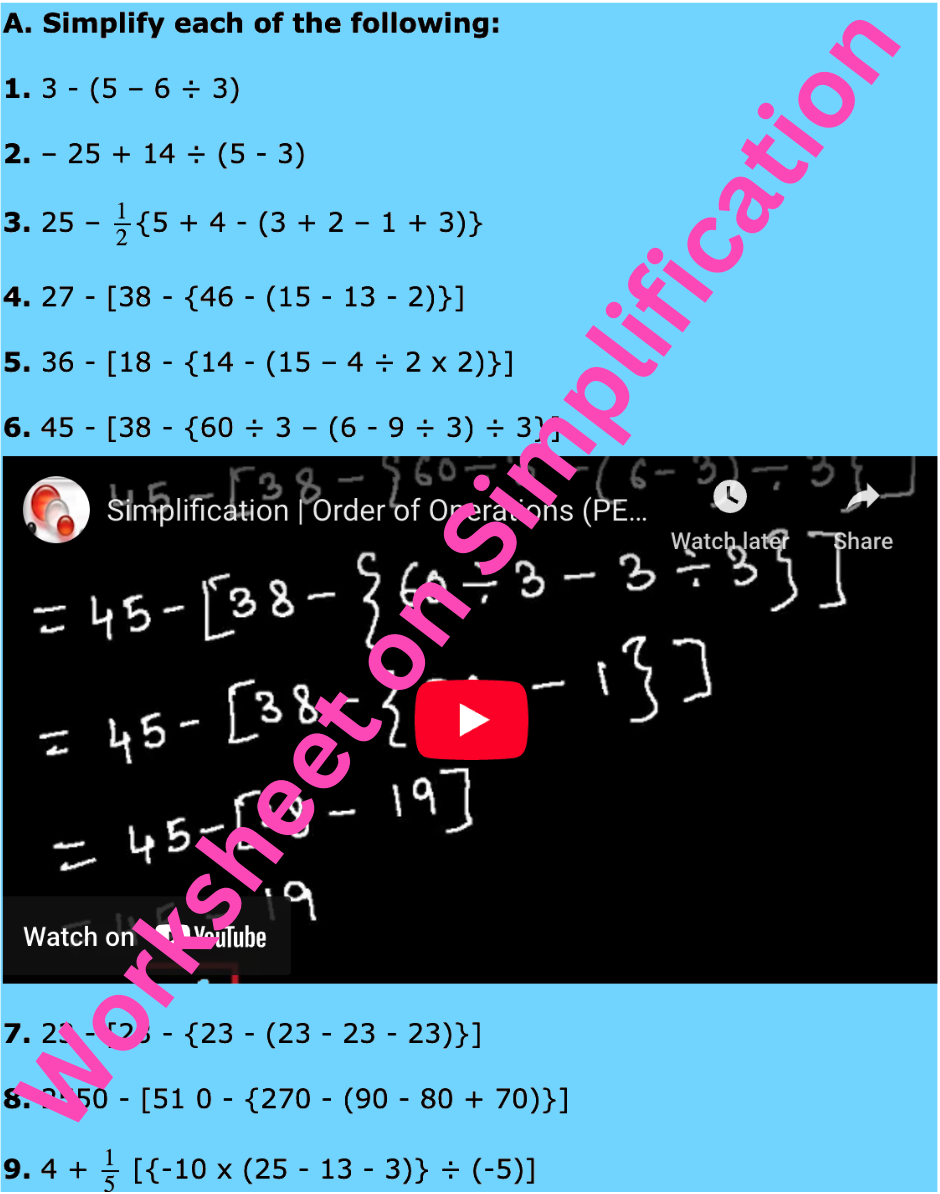Tetrahedron
What is tetrahedron?
A pyramid on a triangular base is called a tetrahedron. In other words, a tetrahedron is a solid bounded by four triangular faces. Evidently a tetrahedron is a triangular pyramid. If the base of a tetrahedron is an equilateral triangle and the other triangular faces are isosceles triangles then it is called a right tetrahedron. A tetrahedron is said to be regular when all its four faces are equilateral triangles. Clearly, these equilateral triangles are congruent to one another.
A regular tetrahedron has been shown in the given figure. M is the vertex and the equilateral triangle JLK is the base of the regular tetrahedron. JL, LK, KJ, MJ, ML and MK are its six edges and three lateral faces are congruent equilateral triangles LKM, KJM and JLM. If G be the centroid of the base JLK and N, the mid-point of the side LK then MG is the height and MN, the slant height of the regular tetrahedron.
Let a be the length of an edge of a regular tetrahedron. Then,
1. Area of the slant surface of the regular tetrahedron
= sum of the areas of three congruent equilateral triangles
= 3 ∙ (√3)/4 a² square units;
2. Area of the whole surface of the regular tetrahedron
= sum of the areas of four congruent equilateral triangles.
= 4 ∙ (√3)/4 a²
= √3 a² square units;
3. Volume of the regular tetrahedron
= 1/3 × area of the base × height
= (1/3) ∙ (√3)/4 ∙ a² × (√2)/(√3) a
= (√2/12) a³ cubic units.
Note:
In the plane ∆ JLK we have, JN ┴ LK
Therefore, JN² = JL² - LN² = a² - (a/2) ² = (3a²)/4
Now, JG = 2/3 ∙ JN
or, JG² = 4/9 ∙ JN²
or, JG² = (4/9) ∙ (3/4) a²
or, JG² = a²/3
Again, MG ┴ JG and JM = a
Hence, from the ∆ JGM we get,
MG² = JM² - JG²
or, MG² = a² - (a²/3)
or, MG² = (2a²)/3
Therefore, MG = (√2a)/√3 = height of the regular tetrahedron.
Worked-out problems in finding surface area and volume of a tetrahedron
1. Each edge of a regular tetrahedron is of length 6 metre. Find its total surface area and volume.
Solution:
A regular tetrahedron is bounded by four congruent equilateral triangles.
By question, each edge of the tetrahedron is of length 6 metre.
Therefore, the total surface area of the tetrahedron
= 4 × area of the equilateral triangle of side 6 metres
= 4 × (√3)/4 ∙ 6² square metre
= 36√3 square metre
Let the equilateral triangle WXY be the base of the tetrahedron. If Z be the mid-point of WX, then YZ ┴ WX
Therefore, from the right - angled ∆ XYZ we get;
YZ² = XY² - XZ² = 6² - 3²
[Since, XY = 6 m. (given) and XZ = 1/2 ∙ WX = 3 m]
or, YZ² = 27
or, YZ 3√3
Let G be the centroid of the triangle WXY. Then,
YG = 2/3 ∙ YZ = 2/3 ∙ 3√3
Let PG be perpendicular to the plane of ∆ WXY at G. Then,
PG is the height of the tetrahedron.
Since, PG ┴ YG, hence from ∆ PYG we get,
PG² = PY² - YG² = 6² - (2√3)², [Since, PY = 6 m]
or, PG² = 36 - 12 = 24
or, PG = 2√6
Therefore, the required volume of the tetrahedron
= 1/3 × (area of ∆ WXY) × PG
= 1/3 ∙ (√3)/4 ∙ 6² ∙ 2√6 cubic metre.
= 18√2 cubic metre.
● Mensuration
- Formulas for 3D Shapes
- Volume and Surface Area of the Prism
- Worksheet on Volume and Surface Area of Prism
- Volume and Whole Surface Area of Right Pyramid
- Volume and Whole Surface Area of Tetrahedron
- Volume of a Pyramid
- Volume and Surface Area of a Pyramid
- Problems on Pyramid
- Worksheet on Volume and Surface Area of a Pyramid
- Worksheet on Volume of a Pyramid
11 and 12 Grade Math
From Practice Tetrahedron to HOME PAGE
Didn't find what you were looking for? Or want to know more information about Math Only Math. Use this Google Search to find what you need.
Recent Articles
-
Counting Numbers from 1 to 50 | Match the Number | Missing Numbers
Apr 04, 25 03:46 PM
In counting numbers from 1 to 50, recognize the numbers, count and then join the numbers in the correct number order. Here we mainly need eye-hand coordination to draw the picture and maintain the num -
Counting Eleven to Twenty with Numbers and Words |Numbers from 11 - 20
Apr 04, 25 03:21 PM
Counting eleven to twenty with numbers and words are explained below. One ten and one more is eleven. Eleven comes after ten. One ten and two more is twelve. Twelve comes after eleven. -
5th Grade BODMAS Rule Worksheet | PEMDAS | Order of operations|Answers
Apr 03, 25 03:11 PM
In 5th Grade BODMAS Rule Worksheet you will get different types of problems on mathematical expressions involving different operations, mathematical expression with 'brackets' and 'of' and simplifying… -
Worksheet on Simplification | Simplify Expressions | BODMAS Questions
Apr 03, 25 02:58 PM
In worksheet on simplification, the questions are based in order to simplify expressions involving more than one bracket by using the steps of removal of brackets. This exercise sheet -
Divisible by 2 Video |Test of Divisibility by 2 Trick| Rules| Examples
Apr 03, 25 10:25 AM
A number is divisible by 2 if the digit at unit place is either 0 or multiple of 2. So a number is divisible by 2 if digit at its units place is 0, 2, 4, 6 or 8.







New! Comments
Have your say about what you just read! Leave me a comment in the box below. Ask a Question or Answer a Question.